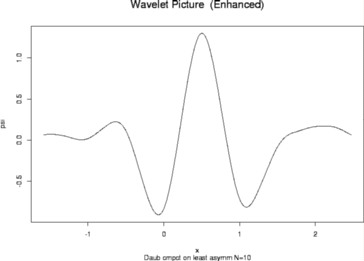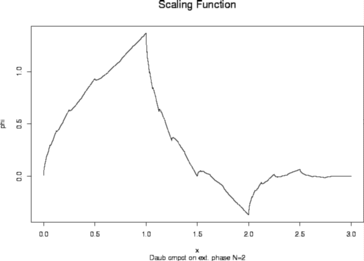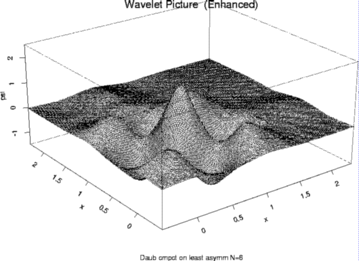WaveThresh
Help
draw.default
Draw picture of a wavelet or scaling function.
DESCRIPTION
This function can produce pictures of one- or two-dimensional
wavelets or scaling functions at various levels of resolution.
USAGE
draw.default(filter.number = 10, family = "DaubLeAsymm", resolution = 8192,
verbose = F, plot.it = T, main = "Wavelet Picture", sub = zwd$
filter$name, xlab = "x", ylab = "psi", dimension = 1, twodplot
= persp, enhance = T, efactor = 0.05, scaling.function = F,
...)
REQUIRED ARGUMENTS
None.
OPTIONAL ARGUMENTS
- filter.number
- This selects the index number of the wavelet or scaling function
you want to draw (from within the wavelet family).
- family
- specifies the family of wavelets that you want to draw.
The options are "DaubExPhase" and "DaubLeAsymm".
- resolution
- specifies the resolution that the wavelet or scaling function
is computed to. It does not necessarily mean that you see all of these
points as if the
enhance option is TRUE then
some function points are omitted.
- verbose
- Controls the printing of "informative" messages
whilst the computations progress. Such messages are
generally annoying so it is turned off by default.
- plot.it
- If
TRUE then this function attempts to plot the
function (i.e. draw it on a graphics device which should be active).
If FALSE then this function returns the coordinates
of the object that would have been plotted.
- main
- a main title for the plot
- sub
- a subtitle for the plot.
- xlab
- a label string for the x-axis
- ylab
- a label string for the y-axis
- dimension
- whether to make a picture of the one-dimensional wavelet or the
two-dimensional wavelet.
- twodplot
- which function to use to produce the two-dimensional plot if
dimension=2. The function you supply should accept
data just like the contour or persp
functions supplied with S-Plus.
- enhance
- If this argument is
TRUE then the plot is enhanced in
the following way. Many of Daubechies' compactly supported wavelets are
near to zero on a reasonable proportion of their support. So if such
a wavelet is plotted quite a lot of it looks to be near zero and the
interesting detail seems quite small. This function chooses a nice range
on which to plot the central parts of the function and the function is
plotted on this range.
- efactor
- Variable which controls the range of plotting associated with the
enhance option above. Any observations smaller than
efactor times the range of the absolute function values
are deemed to be too small. Then the largest range of ``non-small''
values is selected to be plotted.
- scaling.function
- If this argument is
TRUE the scaling function is plotted
otherwise the mother wavelet is plotted.
- ...
- other arguments you can supply to the plot routine embedded within this
function.
VALUE
If plot.it=FALSE then usually a list containing coordinates
of the object that would have been plotted is returned. This
can be useful if you don't want S-Plus to do the plotting or you wish
to use the coordinates of the wavelets for other purposes.
SIDE EFFECTS
A plot is produced of the wavelet or scaling function if
plot.it=TRUE.
DETAILS
The algorithm underlying this function produces a picture of the
wavelet or scaling function by first building a
wavelet decomposition object of the correct
size (i.e. correct resolution) and setting all entries equal
to zero. Then one coefficient at a carefully selected resolution level
is set to one and the decomposition is inverted to obtain a picture
of the wavelet.
RELEASE
Version 3.5.3 Copyright Guy Nason 1994
SEE ALSO
filter.select,
wd,
wd object,
wr,
wr.wd.
EXAMPLES
#
# First make sure that your favourite graphics device is open
# otherwise S-Plus will complain.
#
# Let's draw a one-dimensional Daubechies least-asymmetric wavelet
# N=10
#
draw.default(filter.number=10, family="DaubLeAsymm")
 #
# Wow. What a great picture!
#
# Now how about a one-dimensional Daubechies extremal-phase scaling function
# with N=2
#
draw.default(filter.number=2, family="DaubExPhase", scaling.function=T)
#
# Wow. What a great picture!
#
# Now how about a one-dimensional Daubechies extremal-phase scaling function
# with N=2
#
draw.default(filter.number=2, family="DaubExPhase", scaling.function=T)
 #
# Excellent! Now how about a two-dimensional Daubechies least-asymmetric
# N=6 wavelet
#
# N.b. we'll also reduce the resolution down a bit. If we used the default
# resolution of 8192 this would be probably too much for most computers.
#
draw.default(filter.number=6, family="DaubLeAsymm", dimension=2, res=256)
#
# Excellent! Now how about a two-dimensional Daubechies least-asymmetric
# N=6 wavelet
#
# N.b. we'll also reduce the resolution down a bit. If we used the default
# resolution of 8192 this would be probably too much for most computers.
#
draw.default(filter.number=6, family="DaubLeAsymm", dimension=2, res=256)
 #
# What a pretty picture!
#
# What a pretty picture!
 #
# Wow. What a great picture!
#
# Now how about a one-dimensional Daubechies extremal-phase scaling function
# with N=2
#
draw.default(filter.number=2, family="DaubExPhase", scaling.function=T)
#
# Wow. What a great picture!
#
# Now how about a one-dimensional Daubechies extremal-phase scaling function
# with N=2
#
draw.default(filter.number=2, family="DaubExPhase", scaling.function=T)
 #
# Excellent! Now how about a two-dimensional Daubechies least-asymmetric
# N=6 wavelet
#
# N.b. we'll also reduce the resolution down a bit. If we used the default
# resolution of 8192 this would be probably too much for most computers.
#
draw.default(filter.number=6, family="DaubLeAsymm", dimension=2, res=256)
#
# Excellent! Now how about a two-dimensional Daubechies least-asymmetric
# N=6 wavelet
#
# N.b. we'll also reduce the resolution down a bit. If we used the default
# resolution of 8192 this would be probably too much for most computers.
#
draw.default(filter.number=6, family="DaubLeAsymm", dimension=2, res=256)
 #
# What a pretty picture!
#
# What a pretty picture!